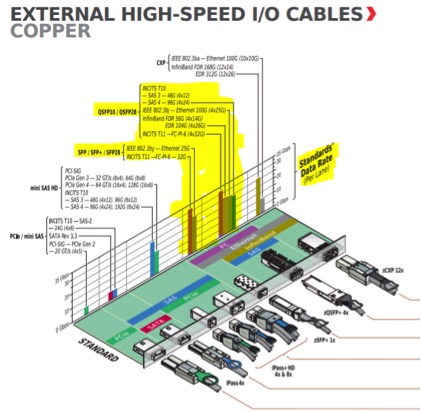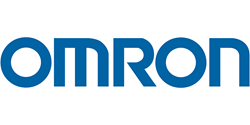What are DACs – and how are they used in the data center?
“Direct Attach Cables” – or DAC cables – are a form of shielded high-speed copper Twinax cable with factory-terminated pluggable I/O (including SFP, SFP+, QSFP and QSFP+) connectors on both ends used in data centers for point-to-point connections of active network equipment. Direct Attach Cables are ideal for high density, high speed I/O data center applications in the networking, telecom and data storage markets where maximum overall network efficiency and lower overall cost are desired.
Maximum lengths for signal integrity
Passive DACs do not amplify or condition the signal in any way. Instead, signals are passed through and regenerated by the host networking equipment. Because of signal integrity needs, passive DACs can only reach up to 5 to 7 meters depending on the speeds and wire gauge. If you need to go a longer distance, you’ll need an active or optic cable and the cost will be higher.
| Attribute | Passive DAC | Active DAC | AOC |
| Cable Type | Twin-axial copper | Twin-axial copper | Fiber optic |
| Maximum Reach | < 7 m | 7-15 m | 100 m+ |
| Power Consumption | < 0.15 W | 0.5-1 W | 1-2 W |
Speeds
DACs deliver a wide range of speeds with SFP capable of running up to 25 Gb/s NRZ today, and QSFP can run 4 such lanes, reaching a total of 100 Gb/s NRZ. Higher speeds lead to shorter maximum lengths. Speeds will continue to increase with new generation QSFP-DD and other advanced DAC technologies.

Active DACs and AOCs
Active DACs, or Active Copper Cables (ACCs), are similar in construction to passive DACs but contain some sort of amplifier and other circuitry in the plug body to extend signal reach. The distance limit of an ACC is about 15 meters, which is about double the length limit of passive DACs. AOCs - Active Optical Cables – are like active DACs in that they consist of a duplex fiber optic cable terminated with pluggable transceiver connectors on both ends. (We’ll cover these active cables in an upcoming article, while we focus on passive DACs in this article.)
The Advantages of DAC cables
Economics – DACs are less expensive than optics. Today’s networks require higher performance from network cabling, as well as cost-effective connectivity. Passive DACs deliver upon both these requirements with their factory terminated performance and reduction in costs by eliminating field terminations, so passive DACs should be chosen when sufficient for the task at hand, usually determined by the length of cable required.<\p>
Power advantages – As speeds go up – and density increases – power is becoming a critical concern in data centers, and DAC cables help manage this issue. DACs consume almost no power, and you don’t have to cool DACs. Power consumption for passive DAC cables is negligible when compared to the use of transceivers because they are self-contained components and not bound by transmission specifications as transceivers.
Plug-and-play simplicity – DACs are only one component to manage rather than multiple components that must be interconnected together. In addition, the installer does not have to be concerned with cleaning and inspecting optical fibers in the field before plugging cables into transceivers.
Higher reliability – DAC cables are in general more reliable than using discreet transceivers with field-connected structure cabling. There are fewer components, no active Tx /Rx components, and the interconnection is simplified, and there aren’t as many connectors, adapters, patch panels, and other infrastructure elements along the path of the communication channel.
Performance: speeds and latency – DAC cables offer support for a wide range of data rates with low latency performance, and the speeds continue to go up to meet new demands. For example, one of the most common applications for DACs is being used with Brocade, Arista, Cisco, Dell and others' network hardware with SFP+ interfaces. This type of connection can transmit at 10 gigabits/second full duplex speed over 5-meter distances. This setup offers 15 to 25 times lower transceiver latency than current 10GBASE-T Cat 6/Cat 6a/Cat 7 cabling systems: 0.1 μs for Twinax with SFP+ versus 1.5 to 2.5 μs for current 10GBASE-T specification.
Introducing Molex DAC cables for data center connectivity
High-speed, efficient networking requires flawlessly integrating cutting edge I/O cables into an integrated equipment solution. Molex cabling solutions support the fastest data rates across the spectrum of distances common in data centers, with excellent signal integrity, lower latency, lower insertion loss and optimal EMI protection. Molex passive DAC cables support all leading equipment vendors and networking protocols. With premium performance cables that support high-speeds with low power requirements, data centers can maximize energy efficiency while supporting current and next-generation applications and protocols.
Molex offers a broad family of passive DACs that go from 1G and 10G – SFP, SFP+, SFP28, 25 GB/s NRZ all the way up to 100G - QSFP28 (zQSFP+®) and – for InfiniBand DACs – 40G QDR QSFP+ and 56G FDR/104G EDR QSFP28 (zQSFP+®).
SFP – The Small Form-Factor Pluggable (SFP) is a compact, hot-pluggable optical module transceiver used for both telecommunication and data communications applications. Standard SFP interconnects are designed to support 1.125 Gbps Fibre Channel and 2.5 Gbps Gigabit Ethernet applications. Sealed SFP optical and electrical integrated assemblies are designed to maximize valuable space on the PCB while providing an environmentally rugged interface. Featuring a panel feed-through design, assemblies incorporate an internally-mounted SFP cage and related electrical circuitry. Because of their low cost, low profile, and ability to provide a connection to different types of cable, SFP provides enhanced flexibility.
SFP FEATURES
-
Supports applications up to 4 Gb/s
-
Cages available in single port, ganged, and stacked configurations
-
Stacked cages have integrated connectors, press-fit in one process step
-
Uses 20 position PT (Pluggable Transceiver) connector
SFP+ – SFP+ interconnects are designed to support applications for 8 Gbps Fibre Channel and 10 Gbps Gigabit Ethernet. SFP+ interconnects use the same space-per-port as standard SFP interconnects. SFP+ – known as the successor technology to 10GBASE-CX4 – has a range of 10 meters and like 10GBASE-CX4, is low power, low cost and low latency with the added advantage of having the small form factor of SFP+, and smaller, more flexible cabling. The target application is interconnection of top-of-rack switches with application servers and storage devices in a rack.
QSFP+ – Quad Small Form Pluggable refers to both a plug and port like SFP/SFP+. As the name implies, it can accommodate 4x the SFP+ data rate through the utilization of four distinct data channels. The connector is slightly larger than an SFP connector. QSFP+ provides a simple upgrade path from 10 Gbps NRZ to 40 Gb/s and 100 Gb/s, with 10 or 25 Gb/s lanes. With PAM4 encoding, QSFP28 is capable of 200 Gb/s total data rate in one pluggable interface. Supporting Ethernet, Fibre Channel, SAS and InfiniBand Enhanced Data Rate (EDR) applications, Molex’s QSFP+ and zQSFP+ Interconnect Systems transmit up to 28 Gbps per-serial-lane and offer thermal protection and Temp-Flex and Optical Cable Assemblies to ensure excellent signal integrity (SI) and prevent electromagnetic interference (EMI).
QSFP+ FEATURES
-
4-channels in one interface, providing 3-4X density of XFP, SFP+
-
Up to 56 Gb/s per channel with PAM4 encoding
-
Single port, ganged and stacked configurations
-
Heatsinks and lightpipes available
QSFP-DD – Data centers are being pushed to support faster processing, more bandwidth, and increased density without sacrificing reliability. In response, QSFP-DD (Quad Small Form Factor Pluggable Double Density) was developed. It utilizes a new module and cage/connector system similar to QSFP, but with an additional row of contacts providing for an eight-lane electrical interface. QSFP-DD doubles the number of high-speed electrical interfaces that the module supports compared with a standard QSFP module. The new Your module format will be able to operate 25 Gb/s NRZ modulation or 50 Gb/s PAM4 modulation over 16 pairs of Twinaxial conductors or optical fibers to support 200 Gb/s or 400 Gb/s aggregate bandwidth.
Turn to Molex for Your DAC Cable Solutions
DAC cables are a cost effective, proven solution for interconnecting networking applications. They use the same port as an optical transceiver, but with significant cost savings and power savings in short-reach applications. Molex offers a broad family of DAC cables to meet today’s needs and is continuing to evolve product offerings to meet industry needs for higher data rates and densities with low power consumption.

10G SFP+ Direct Attach Copper (DAC) cable becomes cloud computing and cloud storage mainstream primary connection tool.

